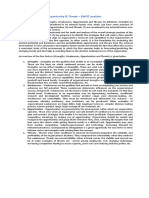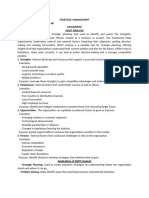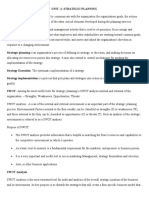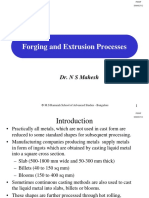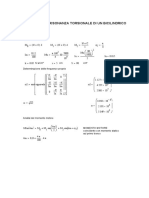SWOT Analysis: - These Are The Qualities That Enable To Accomplish The Organization's Mission. These
Uploaded by
Alessandro MuragliaSWOT Analysis: - These Are The Qualities That Enable To Accomplish The Organization's Mission. These
Uploaded by
Alessandro MuragliaSWOT Analysis
SWOT is the acronym for Strengths, Weaknesses, Opportunities and Threats. It is a strategy analysis
tool. It combines the study of the strengths and weaknesses of an organization, a geographical area,
a sector, an industry, a product or a project with the study of the opportunities and threats to their
environment.
SWOT analysis is a useful tool that can help in handling both ordinary and unusual situations by
exploring both internal and external factors that may be influencing. It is a structured planning method
for strategy formulation. It involves specifying the objective and identifying the internal and external
factors that are favourable and unfavourable for achievement of the objectives. SWOT analysis
usually starts with defining of a desired end state or objective. Strengths are the attributes that are
helpful in achievement of the objective. Weaknesses are the attributes that are harmful in achieving
the objective. Opportunities are the external conditions that are helpful in achievement of the
objective. Threats are the external conditions which could do damage to the objective. Thus strengths
and weaknesses are the internal factors over which there are some measures of control while
opportunities and threats are external factors over which there are essentially no controls (Fig 1).
Fig 1 SWOT analysis
SWOT analysis technique is credited to Albert Humphrey, who led a research team at the Stanford
Research Institute. SWOT analysis came from this research which was conducted from 1960-1970.
The research was funded by the Fortune 500 companies to find out what had gone wrong with
corporate planning and to create a new system for managing change.
To understand SWOT it is necessary to understand the four factors of SWOT. These are explained
below by taking an example of an organization.
Strengths – These are the qualities that enable to accomplish the organization’s mission. These
are the basis on which continued success can be made and sustained. Strengths can be either
tangible or intangible. These are in what the organization is well-versed in or what it has expertise
in. It includes the traits and qualities the employees possess (individually and as a team) and the
distinct features that give the organization its consistency. Strengths are the beneficial aspects of
the organization or the capabilities of an organization and it includes human competencies,
process capabilities, financial resources, products and services, customer goodwill and brand
loyalty. Examples of organizational strengths are huge financial resources, broad product line, no
debt and committed employees etc.
Weaknesses – Weaknesses are the qualities that prevent the organization to accomplish its
mission and to achieve its full potential. These weaknesses deteriorate influences on the
organizational success and growth. Weaknesses are the factors which do not meet the standards
which should be met normally. Weaknesses in an organization may be depreciating machinery,
insufficient research and development facilities, narrow product range and poor decision making,
etc. Weaknesses are controllable. They must be minimized and eliminated. For instance – to
overcome obsolete machinery, new machinery can be purchased. Other examples of
organizational weaknesses are huge debts, high employee turnover, complex decision making
process, narrow product range and large wastage of raw materials etc.
Opportunities – Opportunities are presented by the environment within which the organization
operates. These arise when an organization can take benefit of conditions in its environment to
plan and execute strategies that enable it to become more profitable. Organizations can gain
competitive advantage by making use of opportunities. Organization should be careful and
recognize the opportunities and grasp them whenever they arise. Selection of the targets that
serves the stakeholders while getting the desired results is a difficult task. Opportunities may arise
from market, competition, industry/government and technology.
Threats – Threats arise when conditions in external environment jeopardize the reliability and
profitability of the organization’s business. They compound the vulnerability when they relate to the
weaknesses. Threats are uncontrollable. When a threat comes, the stability and survival can be at
stake. Examples of threats are – unrest among employees; ever changing technology; increasing
competition leading to excess capacity, price wars and reduction in the industry profits etc.
SWOT analysis is not only useful to the profit seeking organization but also it can be used in any
decision making situation where an objective has been defined. SWOT analysis can provide:
A framework for identifying and analyzing the strengths, the weaknesses, the opportunities and
the threats
An impetus for analyzing a situation and developing suitable strategies and tactics
A basis for assessing core competencies and capabilities
An evidence for and a key to change
A stimulus for participating in a group
Steps for SWOT analysis
The following are the steps employed in SWOT analysis.
1. The first step is to define the desired state or objective. The purpose of conducting a SWOT may be
wide or narrow, general or specific.
2. The selection of the contributors for the SWOT analysis is the next step and is Important since it
influences the final outcome. SWOT analysis is the result from consultation and discussion with the
contributors and not just from their personal views, however expert.
3. The third step is background preparation which is important for the subsequent analysis to be
effective. This preparation is carried out in two stages i) Exploratory, followed by data collection, and
ii) Detailed, followed by a focused analysis. The information on strengths and weaknesses is to focus
on the internal factors of skills, resources and assets, or lack of them while the information on
opportunities and threats is to focus on the external factors over which there is little or no control such
as social or economic factors.
4. There is to be flow of information from the contributors. It is important that the information is specific,
evaluative and analytical at the stage of compilation and recording of the SWOT lists. Mere
description is not enough.
5. The next step is listing of strengths. Strengths can relate to the group, to the environment, to the
perceptions, and to the people.
6. After listing of strength listing of weaknesses comes. In this listing it should not constitute an
opportunity to focus on the negative but be an honest appraisal of the way things are. Important
questions for this listing are; (i) What are the obstacles that may prevent progress? (ii) Which
elements need strengthening? and (iii) Are there any real weak links in the chain?
7. The step of opportunities is designed to assess the socio-economic, environmental and demographic
factors, among others, to evaluate the benefits they may bring to the SWOT analysis for examples
the availability of new technology.
8. The next step is the listing of threats. It is the opposite of opportunities and this may with a shift of
emphasis or perception have an adverse impact. Weighing threats against opportunities is not a
reason to indulge in pessimism; it is rather a question of considering how possible negative
experience may be limited or eliminated. The same factors may emerge as both a threat and an
opportunity. Most external factors are in fact challenges, and whether these are perceived as
opportunities or threats is often a valuable indicator of morale.
9. The facts and ideas listed above are sorted and grouped in relation to the objectives. It may be
necessary for the SWOT analysis to select the five most important items from the list in order to gain
a wider view. Clarity of objectives is the key to the process, as evaluation and elimination is
necessary to remove the unnecessary items. Although some aspects may require further information,
a clear picture should emerge at this stage in response to the objectives.
10. It is to be ensured that the SWOT analysis is used in subsequent planning.
Dos and don’ts for SWOT analysis
Do
Be analytical and specific.
Record all thoughts and ideas in stages 5-8.
Be selective in the final evaluation.
Choose the right people for the exercise.
Choose a suitable SWOT leader or facilitator.
Don’t
Try to disguise weaknesses.
Merely list errors and mistakes.
Lose sight of external influences and trends.
Allow the SWOT to become a blame-laying exercise.
Ignore the outcomes at later stages of the planning process.
Advantages
Advantages of SWOT analysis are as follows
1. It is a source of information for strategic planning.
2. It builds the strength of the organization.
3. It reverses the weaknesses of the organization.
4. It maximizes the response to the opportunities.
5. It helps in overcoming the threats to the organization.
6. It helps in identifying core competencies of the organization.
7. It helps in setting of objectives for strategic planning.
8. It helps in knowing past, present and future so that by using past and current data, future plans can
be chalked out.
You might also like
- Performing A SWOT Analysis (Checklist 005) (Strengths Weaknesses Opportunities Threats)No ratings yetPerforming A SWOT Analysis (Checklist 005) (Strengths Weaknesses Opportunities Threats)5 pages
- SWOT Analysis and Comparison of Air India and BSNLNo ratings yetSWOT Analysis and Comparison of Air India and BSNL14 pages
- Strength Weakness Opportunity & Threat - SWOT Analysis100% (3)Strength Weakness Opportunity & Threat - SWOT Analysis3 pages
- SWOT Analysis For Entrepreneur - Theeranaipunya - ShinojNo ratings yetSWOT Analysis For Entrepreneur - Theeranaipunya - Shinoj4 pages
- Internal and External Factors: Planning Project BusinessNo ratings yetInternal and External Factors: Planning Project Business3 pages
- Strategic Planning Project Business: SWOT Analysis Is ANo ratings yetStrategic Planning Project Business: SWOT Analysis Is A1 page
- SWOT Analysis Toolkit Guide Final EnglishNo ratings yetSWOT Analysis Toolkit Guide Final English10 pages
- SWOT Analysis: SWOT Is An Acronym For Strengths, Weaknesses, Opportunities and ThreatsNo ratings yetSWOT Analysis: SWOT Is An Acronym For Strengths, Weaknesses, Opportunities and Threats14 pages
- Interpolation Model of Fatigue Crack Propagation Data Modello Per L'interpolazione Dei Dati Sperimentali Di Crack PropagazioneNo ratings yetInterpolation Model of Fatigue Crack Propagation Data Modello Per L'interpolazione Dei Dati Sperimentali Di Crack Propagazione12 pages
- Studio Della Risonanza Torsionale Di Un BicilindricoNo ratings yetStudio Della Risonanza Torsionale Di Un Bicilindrico7 pages
- (Forgiatura), (Imbutitura Rotante Al Tornio) and GeneralNo ratings yet(Forgiatura), (Imbutitura Rotante Al Tornio) and General4 pages
- Essentialism - The Disciplined Pursuit of Less Greg McKeown-Sheet 1No ratings yetEssentialism - The Disciplined Pursuit of Less Greg McKeown-Sheet 11 page
- A Mind For Numbers - Barbara Oakley - Memorization Booklet90% (10)A Mind For Numbers - Barbara Oakley - Memorization Booklet26 pages
- Factors Affecting Project Implementation Amongst100% (2)Factors Affecting Project Implementation Amongst48 pages
- Consumer Influence and Diffusion of InnovationsNo ratings yetConsumer Influence and Diffusion of Innovations29 pages
- Aurora Pioneers Memorial College: Offline Learning Module 1 GE 107 Rizal's Life and WorksNo ratings yetAurora Pioneers Memorial College: Offline Learning Module 1 GE 107 Rizal's Life and Works23 pages
- Lesson 2-5: Proving Angles Congruent: Geometric ProofsNo ratings yetLesson 2-5: Proving Angles Congruent: Geometric Proofs5 pages
- EEE 482 Introduction To State-Space Methods (3) (F)No ratings yetEEE 482 Introduction To State-Space Methods (3) (F)2 pages
- Talent Management Is A Set of Integrated Organizational HR Processes Designed To AttractNo ratings yetTalent Management Is A Set of Integrated Organizational HR Processes Designed To Attract8 pages
- Teaching MAPEH On Elementary Grades Syllabus by Jeiar BurgosNo ratings yetTeaching MAPEH On Elementary Grades Syllabus by Jeiar Burgos7 pages



























